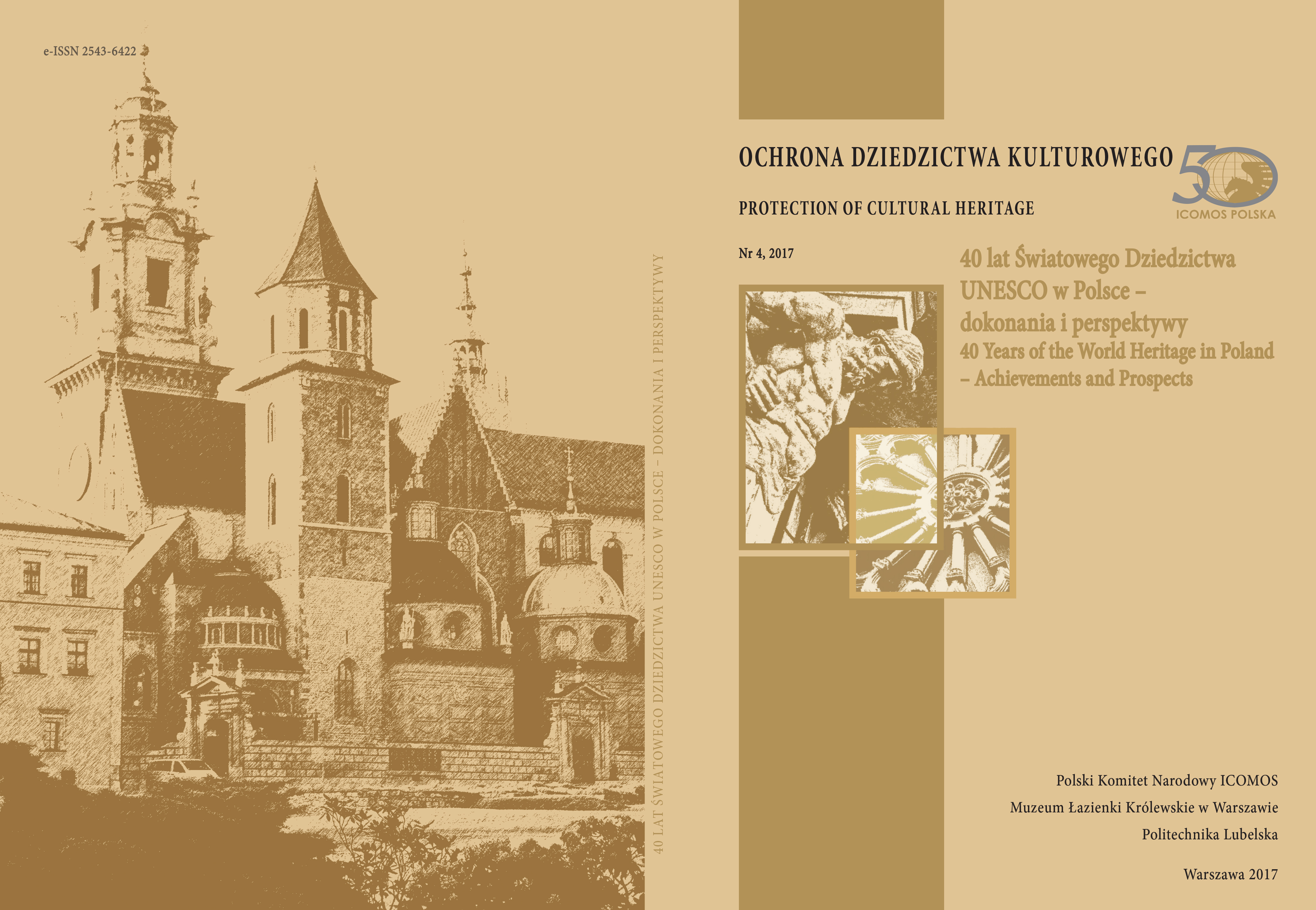Consequences of entering assets into the UNESCO List – prestige and what next?
Article Sidebar
Open full text
Issue No. 4 (2017)
-
Civic Committee for the Restoration of Cracow Heritage: origin, experience, programme
Bogusław Krasnowolski7-14
-
Historic monument – the Gniezno Cathedral – the dominant monument of the city landscape now and in the past
Magdalena Meller, Karolina Kowalska15-20
-
Cultural landscape on the World Heritage List - Polish experiences
Andrzej Michałowski21-30
-
Adaptation of buildings of historical significance in Gdańsk. The key issues of Regional Heritage Protection Officers’ perspective
Karolina Szczepanowska31-46
-
Prospects for inscribing certain elements of the cultural landscape of Szczecin as a Polish listed monument
Zbigniew Władysław Paszkowski, Jakub Ignacy Gołębiewski, Izabela Kozłowska47-62
-
Gdańsk on the UNESCO World Heritage List - 20 years of attempts and missed opportunities
Marcin Gawlicki63-72
-
Consequences of entering assets into the UNESCO List – prestige and what next?
Ewelina Kowalska73-81
-
Churches of Peace in Jawor and Świdnica – conservation work of the interior and furnishings, as an example of protecting buildings inscribed on the World Heritage List
Małgorzata Korpała83-92
-
The authenticity of painted decorations of the Old Town in Warsaw
Anna Jagiellak93-103
-
Management Plans for the Churches of Peace in Jawor and Swidnica as an Example of Management Problems with UNESCO World Heritage Site
Waldemar J. Affelt105-120
-
Ideas and assumptions of The Convention concerning the Protection of World Cultural and Natural Heritage and their implementation in Poland from the perspective of the Polish UNESCO Committee
Sławomir Ratajski121-126
-
Poland’s participation in initial efforts to implement resolutions of the Convention
Krzysztof K. Pawłowski127-134
-
The perspectives of protection of the world heritage in Poland – the tentative list and proposals of nominations to the world heritage list
Jakub Lewicki129-142
-
Places of memory under UNESCO 1972 World Heritage Convention and criterion VI of the Op erational Guidelines of its implementation
Wojciech Kowalski149-162
-
The role of the “League of Polish Cities and UNESCO Sites” in the preservation of Cultural Heritage
Zbigniew Fiderewicz163-165
Main Article Content
DOI
Authors
Abstract
In Poland there are 70 facilities recognised as monuments of history, 14 of which are listed on the UNESCO World Heritage list. From the point of view of the effects in terms of national recognition for the historical monument, it has a prestigious meaning. Given the distinction of cultural monuments as a separately governed issue by article. 7 of the Polish Act on Antiques’ Protection and Care, a question is raised debating the ratio legis of this institution. The possibility to apply for entry onto the UNESCO list is the only result of this legal regulation. However, what is the most problematic – the entry of such historic monument onto this exclusive List also does not constitute a change in terms of the legal status of such an object. The aim of this paper is to analyse the issue of the real and effective judicial protection of, both historic monuments as well as the facilities included in the list of World Heritage.
Keywords:
References
Dobosz P., Uwarunkowania i możliwości wykorzystania prawa w zarządzaniu dobrami wpisanymi na Listę Światowego Dziedzictwa UNESCO zlokalizowanymi na terenie Polski [w:] Wybrane zagadnienia zarządzania dobrami UNECSO w Polsce, (red.) B. Szmygin, Warszawa 2015.
Frączak K., Skuteczność ochrony pomników historii w prawie polskim [w:] Prawo ochrony zabytków, Warszawa–Gdańsk 2014.
http://ww.icomos-poland.org/dokumenty-doktrynalne.html (dostęp: 15.05.2017).
Jagielska-Burduk A., Nowy wizerunek dziedzictwa – między ochroną a zarządzaniem [w:] Jagielska-Burduk A., Szafrański W., Gaweł Ł., Mechanizmy prawne zarządzania dziedzictwem kultury, (red.) A. Jagielska-Burduk, Gdańsk–Warszawa 2016.
Jagielska-Burduk A., Zabytek ruchomy, Warszawa 2011.
Konwencja w sprawie ochrony światowego dziedzictwa kulturalnego i naturalnego, przyjęta w Paryżu dnia 16 listopada 1972 r. (Dz. U. z 1976 r. Nr 32, poz. 190).
Ustawa z dnia 10 lipca 2015 r. o zmianie ustawy o ochronie zabytków i opiece nad zabytkami oraz ustawy o muzeach, Dz. U. z 2016 r., poz. 1330.
Ustawa z dnia 23 lipca 2003 r. o ochronie zabytków i opiece nad zabytkami (tekst jedn. Dz. U. z 2014 r.,poz. 1446 ze zm.).
Zalasińska K., Prawna ochrona zabytków nieruchomych w Polsce, Warszawa 2010.
Zeidler K., Prawo ochrony dziedzictwa kultury, Warszawa 2007.
Article Details
Abstract views: 303
Ewelina Kowalska, Faculty of Law and Administration of the University of Gdańsk
doktor nauk prawnych, adiunkt w Centrum Prawa Własności Intelektualnej Wydziału Prawa
i Administracji Uniwersytetu Gdańskiego. Rozprawę doktorską na temat Własność zabytku a dyskrecjonalna
władza konserwatorska obroniła z wyróżnieniem w listopadzie 2016 r. Autorka publikacji
m.in. z zakresu prawa ochrony dziedzictwa kultury. Od 2015 r. wpisana na listę adwokatów Okręgowej
Rady Adwokackiej w Gdańsku.






